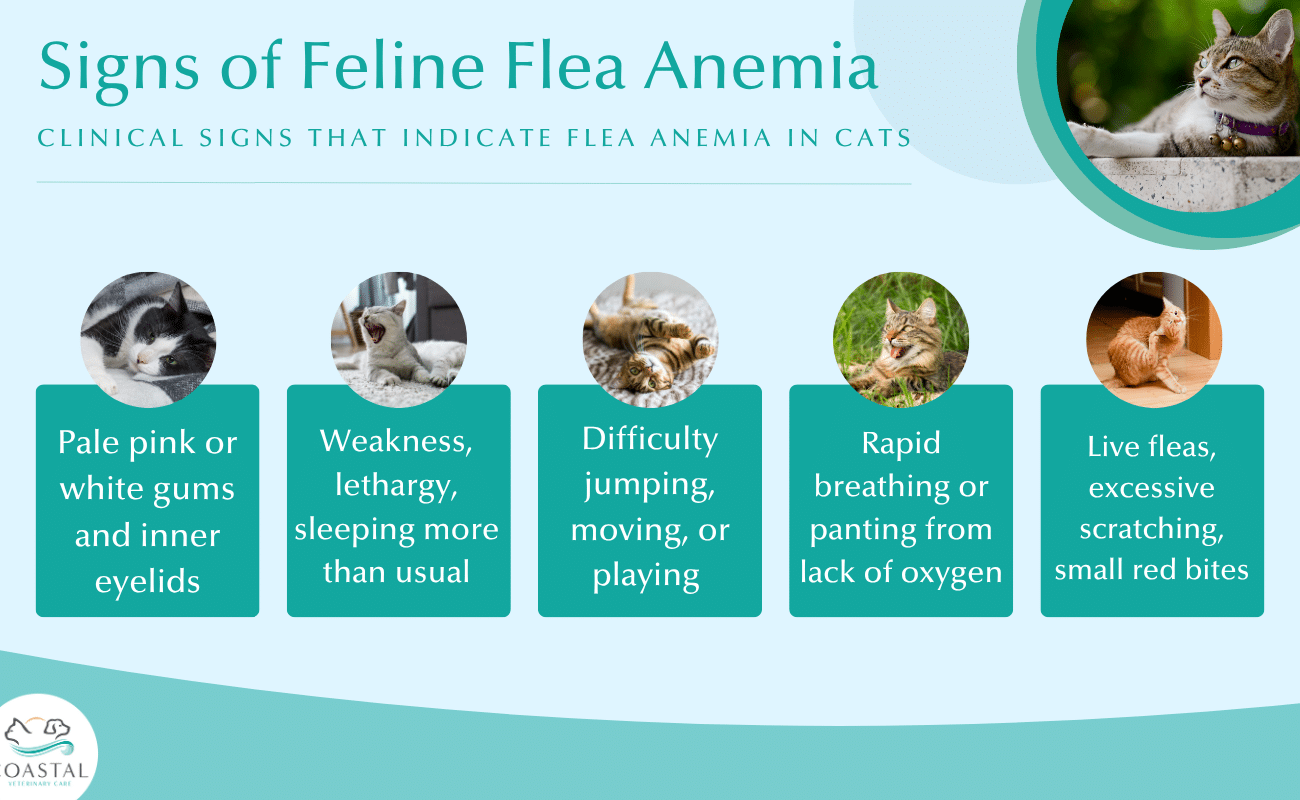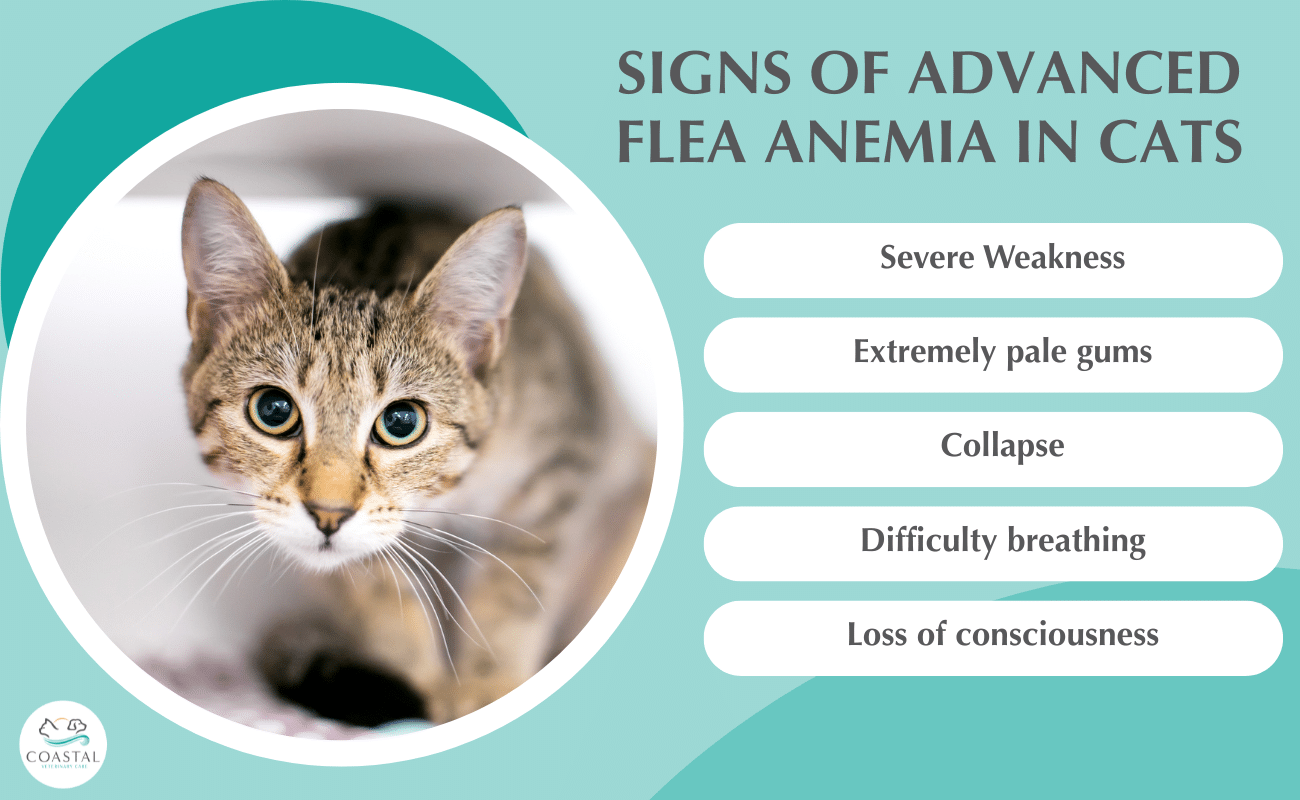Flea Anemia in Cats: A Pet Owner’s Guide to Prevention and Treatment
Flea infestations might seem like a minor annoyance, but they can lead to serious health complications for cats. One of the most dangerous conditions that can develop is flea anemia – a potentially life-threatening situation that occurs when blood-sucking parasites consume so much of your cat’s blood that their red blood cell count drops to dangerous levels.
Pet owners, especially those living in warm climates like Myrtle Beach, where fleas thrive year-round, should understand and recognize the risks of flea anemia. Recognizing the warning signs and knowing when to seek immediate veterinary care can mean the difference between a manageable health issue and a life-threatening emergency for your feline friend.
This guide will help you understand the warning signs of flea anemia, learn which cats are most at risk, know when to seek emergency veterinary care, and discover effective ways to prevent this serious condition from affecting your cat.
What is Flea Anemia?
Flea anemia occurs when blood-sucking parasites like the cat flea drain so much blood that your cat develops anemia. Though mild flea infestations may seem harmless, severe cases can cause dangerous blood loss, especially in kittens or cats with underlying causes like feline leukemia virus.
Adult fleas feed on blood, and in large numbers, outpace the body’s ability to replace lost red blood cells. Signs include pale gums, flea dirt, and live fleas. Without flea control, some anemic cats may need a blood transfusion.
Unlike humans, cats have a relatively small blood volume for their body size, making them particularly vulnerable to blood loss from flea infestations. What might be manageable for a larger animal can quickly become critical for our feline friends.
Recognizing the Signs of Flea Anemia
Early detection is crucial for your cat’s health and survival. Pet owners should watch for these clinical signs:

Physical symptoms:
-
- Pale gums: one of the most reliable indicators of anemia (healthy cats have pink gums, anemic cats have white or very pale pink gums)
- Pale inner eyelids
- Weakness and lethargy that go beyond normal cat sleepiness
- Difficulty jumping onto furniture or seeming unusually tired after minimal activity
Behavioral changes:
-
- Hiding more than usual
- Sleeping excessively
- Showing little interest in food or play
- Having trouble maintaining normal body temperature
- Rapid breathing or panting as their bodies struggle to deliver oxygen with fewer red blood cells
Evidence of flea infestation:
-
- Live fleas are moving through your cat’s fur
- Flea dirt (pepper-like specks that turn reddish-brown when moistened)
- Excessive scratching
- Small red flea bites on your cat’s skin
- Use a flea comb to help detect both live fleas and flea dirt, even when fleas aren’t immediately visible
Cats at Highest Risk
While any cat with a severe flea infestation can develop anemia, certain cats face greater danger. Kittens are especially vulnerable because of their small size and developing immune systems. Young cats under one year old can develop life-threatening anemia much faster than healthy adults.
Senior cats and those with underlying health conditions like feline leukemia virus, chronic kidney disease, or other illnesses that affect their immune system also face increased risk. These cats may already have compromised red blood cell production or other health challenges that make them less able to cope with blood loss.
Outdoor cats and those in multi-pet households often experience more severe infestations because they have greater exposure to fleas and may harbor other intestinal parasites that compound their health problems.
When Flea Anemia Becomes an Emergency
Flea anemia can progress rapidly from manageable to life-threatening. Seek immediate veterinary care if your cat shows:
-
- Severe weakness
- Collapse
- Extreme pale gums
- Difficulty breathing
- Loss of consciousness
These signs indicate that your cat’s condition has become critical and requires emergency intervention.

At Coastal Veterinary Care, we’re equipped to handle these emergencies. In severe cases, cats may require blood transfusions to replace lost red blood cells and stabilize their condition. Time is critical; the sooner treatment begins, the better your cat’s chances of full recovery.
Diagnosis and Treatment
A veterinarian must diagnose and treat flea anemia, as this condition cannot be properly managed without professional care. Your veterinarian will begin with a thorough examination, including checking for signs of flea infestation and assessing the severity of anemia through blood tests. Your cat’s gums will be examined, the heart and lungs will be listened to, and bloodwork may be recommended to determine red blood cell count and overall health status.
Treatment approaches depend on the severity of the anemia. Mild cases may respond well to aggressive flea control and supportive care, while severe cases often require blood transfusions. Immediate flea control will be implemented to address the underlying cause, and medications may be prescribed to support your cat’s recovery.
Supportive care might include intravenous fluids, medications to stimulate red blood cell production, and treatment for any secondary infections or complications. Recovery time varies, but most cats show improvement within days of starting treatment, with full recovery taking several weeks.
Prevention: Your Best Defense
Preventing flea infestations is far easier and less expensive than treating flea anemia. Year-round flea prevention is essential, even for indoor cats, since fleas can enter homes on clothing, other pets, or through open doors.
Modern flea control products are highly effective. Fast-acting flea-killing tablets can eliminate adult fleas quickly during active infestations, while monthly preventatives provide ongoing protection. These effective products target fleas at different life stages, breaking the flea life cycle and preventing new infestations.
Environmental control is equally important. Vacuum regularly, wash pet bedding frequently, and treat soft furnishings where flea eggs might hide. Be wary of flea bite allergy and flea allergic dermatitis, which can develop alongside flea infestations. Some cats become sensitized to flea saliva, developing intense itching and skin problems that compound the blood loss problem.

Supporting Your Cat’s Recovery
If your cat is recovering from flea anemia, proper nutrition supports red blood cell regeneration. High-quality protein and iron-rich foods help the bone marrow produce new blood cells. Create a quiet, comfortable environment where your cat can rest undisturbed.
Monitor your cat’s progress by checking gum color daily and watching for returning energy and appetite. Continue all prescribed medications and flea control measures as directed, even after your cat seems better.
The Bottom Line
Flea anemia is a serious but preventable condition. With proper flea prevention, regular veterinary care, and prompt attention to warning signs, pet owners can protect their cats from this dangerous complication of flea infestations.
At Coastal Veterinary Care, we’re committed to helping Myrtle Beach pet owners keep their cats healthy and flea-free. Whether you need emergency care for a sick cat or want to establish a prevention plan, our team is here to help. Don’t wait until flea problems become life-threatening – contact us today to discuss the best flea prevention strategy for your feline family members.
Remember: when it comes to fleas and your cat’s health, prevention is always better than treatment. But if you suspect flea anemia, seek veterinary care immediately. Quick action can save your cat’s life.
Choose Coastal Veterinary Care in Myrtle Beach, SC
At Coastal Veterinary Care, we can help you determine an appropriate veterinary schedule that best supports your pet’s needs. From planning regular routine visits to understanding what to look for to identify when your pet may need to be seen to evaluate a specific injury or illness, we are here to help you make sure your pet gets the best possible care. Contact us today to learn more about why we are a trusted choice among pet owners in the Myrtle Beach, SC, area or to schedule an appointment!
